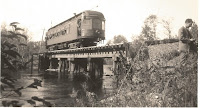From the Schmidt Photo Collection, we have a selection of miscellaneous traction photos filed together under the heading "Interurban Lines". These are all quite interesting, and I will add some comments as necessary.
Windsplitter
Here is a Winona Interurban windsplitter on the streets of Indianapolis. The photo is not otherwise identified.
Binghamton-Scranton
The Scranton and Binghamton Railway interurban line never reached Binghamton, only going from Scranton to Montrose, Pa. and was abandoned in 1931. Pictures of this line are very rare. This presumably shows the Scranton carbarns.
Bush Terminal Railroad
Indiana Service Company
Freight train on the line to Waterloo, 1943:
After the end of the Indiana Railroad in 1940, the Indiana Service Co. retained the line from Ft. Wayne to Garrett (on the Waterloo line) to haul coal to its power plant until 1945. And as seen below, evidently they had at least one streetcar that could be chartered.
Northampton
Northampton Transit was a standard-gauge Pennsylvania interurban which ran between Easton and Portland. It was abandoned in 1933.
Omaha
Switcher at the Omaha municipal power plant, June 1949.
Indianapolis and Cincinnati
This line was originally equipped with single-phase AC. c. 1918. This would appear to be the junction between the two main lines on the east side of Indianapolis.
Sacramento Northern
Locomotive 603 at 40th St., Oakland, 4:30pm.
SN 1005 at Oakland Terminal yard. This car has been preserved and beautifully restored by WRM.
Southern New York
Two photos by E. J. Quinby of the NRHS Fan Excursion over the Southern New York interurban line on Oct. 2, 1938, shortly before abandonment.
Special
The back of the photo says:
The Lewis-Powelson Special
Ft. Wayne, Ind.
Sept. 1943
Powelson in a typical Napoleonic stance
Wilkes-Barre
Car 352, no info on back.














4 comments:
Wouldn't the windsplitter at Indianapolis be the Perdue test car that is preserved at the St.Louis Museum of Transportation? The Bush Terminal locomotive appears to be an early battery electric, perhaps, with link and pin couplers.
O. Anderson
Hello, Frank - mystery car 352 is indeed a Wilkes-Barre car. The photo is taken from Public Square facing South Main Street. That area has changed a lot over the years.
Here are a couple links:
https://www.digitalcommonwealth.org/search/commonwealth:2b88qd15d
https://www.zazzle.com/trolley_in_wilkes_barre_postcard-239188146245206106
Harvey's Lake car, part of the WB line looks very similar:
http://harveyslake.org/text/story_lakeline_02.html
Thanks,
Rocco
Re: The Bush Terminal motor / car;
Bush already had a fleet of five Baldwin 0-4-0T for railroad use purchased 1901-04; and were equipped with MCB style couplers. So, this Hicks motor having link and pink would not have been used in interchange service.
Then it was thought it was a electric trolley motor for street running, but it lacks a trolley pole (admittedly, it could very well not yet be installed). Proceeding along this line of postulation, its very lightweight construction would not offer much tractive effort. It has no headlight on either end that would indicate it could lead a train. But in examining the undercarriage, there does not appear to be any electrical cable connections to the trucks nor are traction motors seen.
Perhaps the small hoods contain storage batteries for say, shifting cars inside a warehouse. For this use though, the link and pin couplers would be applicable in their usage as several of the piers had standard gauge trackage through them and photo evidence shows Bush Terminal using small 4 wheel carts with link and pins and battery powered "mules" (similar to an open forklift motor).
Or they could simply contain weight for ballast. There are doors on the front and rear of the cab accessing the hoods as well as the sides. Nor are airbrake cylinders or brake hoses seen, and the shadow of a handbrake wheel can be seen inside the cab.
Some form of friction braking system is evident by the presence of brake shoes. Whether these are manual or electric, remains to be learned. It does have wood plow beams to the outside of the trucks indicating it could push aside obstructions. Note the post pockets along the sides, typical of what you would find on early flat cars.
So, while we have a decent history of the manufacturer, all these answers do not answer the inevitable questions: what is this equipment and what was its purpose for Bush Terminal?
Philip M. Goldstein
freightrrofnyc.info ~ Bush Terminal Railroad
Hi Philip,
Thanks for posting! I'm a big fan of your New York Terminal Railroads site.
For what it's worth, unless you have information from elsewhere, I strongly doubt this was built by Hicks. Our blog covers a wide range of traction subjects, not just equipment built by Hicks, and this is a random print from the collection of a (now-deceased) contributor. That background looks kind of distinctive, so if anyone recognizes it, that could be a clue as to who built this thing.
Other than that, I think your analysis is spot-on, and I agree that it's confusing as to what exactly we're looking at. My best guess is that it is indeed an electric (trolley) locomotive, and possibly one that hasn't yet been equipped with its electric gear. This wasn't all that uncommon; the Hicks-built interurban car preserved at our museum was delivered from the builder without any electric gear, and that gear was fitted by the railroad. That could explain the lack of trolley poles, wires, and resistance grids.
I suspect it isn't a battery locomotive because you'd need more space for batteries, whereas a trolley locomotive would need relatively little room for equipment. There's a cab-on-flat locomotive preserved in Kansas that has a very similar profile, with a square cab in the center and these low sloped porches on either end; it's been rebuilt, but on that locomotive it appears the sloped porches are there for weight and may contain ballast, in effect, to increase tractive effort. Not conclusive, but that's my best guess.
Post a Comment